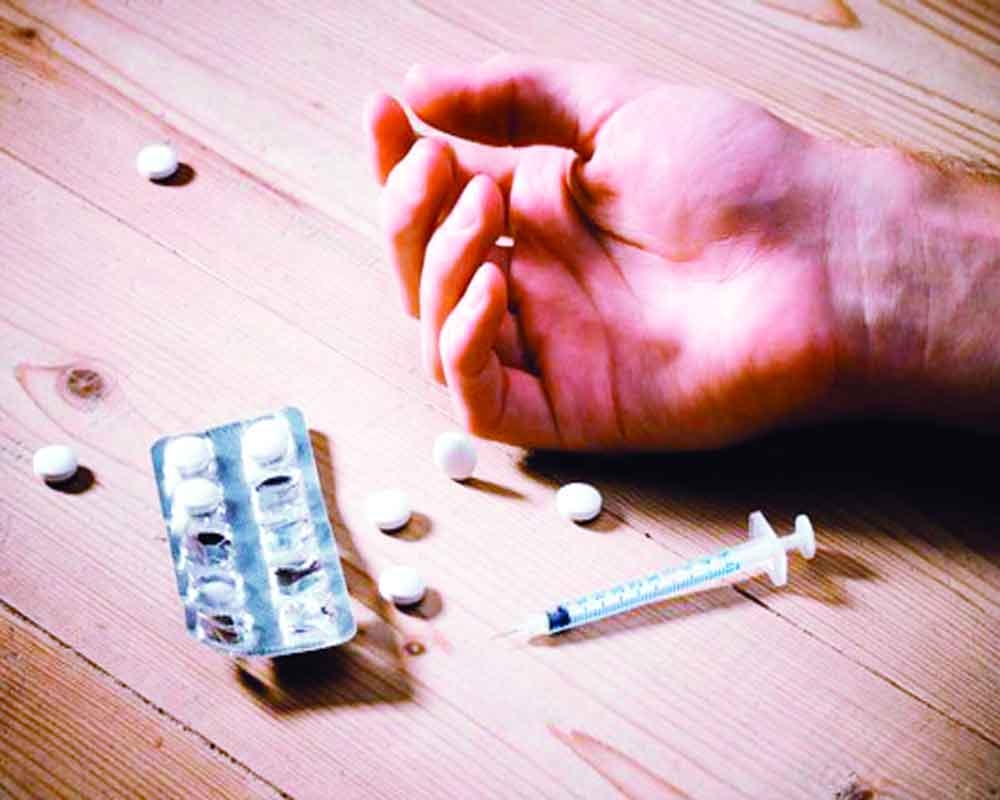Alcohol continues to be the most common psychoactive substance used in India though its prevalence varies across the states, says SB Shashank
Drug menace is so alarming worldwide that the special session of UN General Assembly on drug policy, which was scheduled to take place this year was brought forward to take place in year 2016. There are three international conventions, namely, Single Convention on Narcotic Drugs, 1961, Convention on Psychotropic Substances, 1971 and Convention against Illicit Traffic in Narcotic Drug and Psychotropic Substances, 1988 to which India is a signatory. It covers India’s commitment to the international community in combating the use and abuse of psychotropic substances. At home, there is a policy document which was brought out in 2012 by the Ministry of Social Justice and Empowerment to guide ministries, state governments, NGOs, international organisations on gamut of issues related to reduction in demand and supply, relief and rehabilitation.
Recently, the ministry released findings of a nationwide comprehensive survey, which was undertaken last year to know magnitude, spread and extent of substance use in the country. This document provides data across all the states, for the first time, about the extent of problem and will enable policy makers and planners in determining the target of demand reduction and further in identifying focus areas which are to be prioritised. The survey report will prove to be milestone in our fight against the substance use and problem. When compared to the previous survey, which was conducted in 2001 with turn of the millennium, though with limited sample size, the trend in use and abuse shows rise over last eighteen years. To reverse the trend requires more focus on policy gap and implementation strategy.
As the survey report shows, alcohol continues to be the most common psychoactive substance used in India though its prevalence varies across the states. In contrast to the common perception that Udta Punjab may be the numero uno, what is surprising is that Chhattisgarh occupies top position both in prevalence of use and dependence followed closely by Tripura and Punjab in that order. The national average is that every seventh person is current user of Alcohol and out of that, every fifth person requires medical intervention for being alcohol dependent. On gender classification on use, men constitute 27.3 per cent of population whereas women constitute just 1.6 per cent. This also gives strong reason to support why women should be involved in combating alcohol abuse as some states have also shown by example. Delhi with 21.3 per cent of population as current user of alcohol is much above the national average of 14.6 per cent and use disorder at 6.2 per cent is also much above the national average of 5.2 per cent.
Cannabis and Opioids occupy the second and third position in prevalence of substance use. On national level 3.1 crore people 2.8 per cent use cannabis which includes bhang, hashish (charas) and weed (ganja), which is more harmful than the former. Every fourth user is either suffering from harmful use or from dependence requiring intervention. The states of Uttar Pradesh, Punjab, Sikkim, Chhattisgarh and Delhi top the list and have prevalence more than the national average. Sikkim and Punjab have much higher cannabis use disorder than other states.
The most common opioid used are heroin, pharmaceutical opioid and opium coming in same order in use prevalence showing that heroin is now the predominant opioid which is a major shift in use pattern. But in southern states pharmaceutical opioids are predominantly used. On national level 2.06 per cent of population come under the category of current users and around one third of them are problem users requiring intervention. Among the states Mizoram, closely followed by Nagaland, tops the chart of use where the prevalence is more than 12 times the national average. Punjab (9.69 per cent) and Delhi (7.79 per cent) also have much higher user load, with significant proportion requiring corrective interventions, than national average of 2.06 per cent.
Sedatives and inhalants are also used as psychoactive substance. About 1.18 crore people (1.08 per cent) use sedatives which are non medical and non prescriped. North eastern states Sikkim, Nagaland, Mizoram, Manipur top the chart in maximum prevalence in use of sedatives. Among all the substances, inhalants are the only substance for which prevalence of use among children and adolescents are more than adults. At national level 4.6 lakh children and 18 lakh adults require intervention for being problem users of inhalants.
With this survey report, the states have their tasks cut out to accelerate the action to combat the menace of substance abuse. June 26 is observed as the International Day against Drug Abuse and Illicit Trafficking. The states joined the world community in creating more awareness about the gigantic problem. To many, such symbolism may not impress but it is significant so long as it goes beyond symbolism per se with resolve.
(The writer is an IAS officer and director of Department of Women and Child Development, GNCTD dealing with the matter of Prohibition.)


























